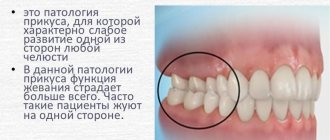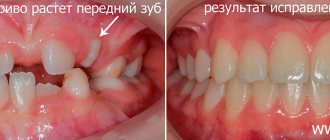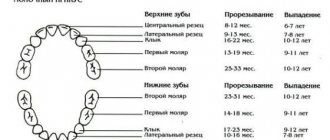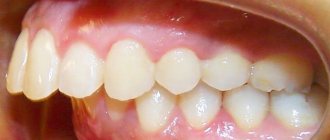If your child speaks poorly or you notice obvious signs of malocclusion in your baby, you should go for a consultation with a pediatric dentist. You can get rid of these and other problems with a simple procedure - you need to correct a short frenulum of the tongue in a child.
The frenulum of the tongue is a bridge that connects the tongue and the lower palate. It is responsible for how the tongue functions, affects speech, the ability to drink and eat, and swallow. The condition of the frenulum even affects the breathing process!
Here there is the possibility of pathology consisting in insufficient length, which leads to the recommendation to trim the frenulum of the child’s tongue. Why is it needed?
Let's consider the reasons for the need for this operation for children from a very early age. For newborn babies, sucking is a vital function. It is she who suffers in case of frenulum pathology. If it is not trimmed, the baby will not be able to drink mother's milk, including from a bottle with a nipple. It must be said that surgery in early childhood is easier to tolerate than in adulthood, so parents should not worry about the baby’s well-being.
Further, if a short frenulum of the tongue is detected at an older age, doctors advise surgery to prevent the defect from affecting the formation of the bite, and to avoid speech problems and disturbances in the process of eating.
What is it and why do we need it?
Such anatomical formations are the thinnest folds of the mucous membrane that connect the mobile lips and tongue with the fixed parts of the oral cavity: the gums and the sublingual space.
In total, there are three frenulums in the baby’s mouth:
- Tongue - located under the tongue.
- Upper lip - localized between the upper lip and the gum mucosa above the level of the central incisors.
- Lower lip - connects the inner surface of the lower lip with the gums at the level of the middle of the alveolar process on the lower jaw.
Despite their small size, such mucous folds are of great importance in human life. In a newborn, they are responsible for proper attachment to the mother's nipple. In older children, the frenulum is involved in the correct pronunciation of sounds and in the formation of a normal bite.
Why is a short frenulum a problem?
The tongue is limited in movement - what does this lead to? The main problem that is relevant for infants is that the child cannot fully suckle at the breast, he is simply not able to grasp the nipple correctly. The baby cries and turns away from the breast after unsuccessful attempts to get food. The mother's breast, filled with milk, does not empty after the baby is attached. Thus, lactation is not stimulated - milk does not come. As a result, the child is hungry, loses weight, and the woman may experience problems with her breasts: stagnation of milk. As a result, parents have to switch the baby to artificial feeding: it is much easier to suck formula from a bottle, and the incorrect structure of the frenulum is not a hindrance here.
The second problem associated with a shortened hyoid ligament appears in older children - during the period when the child begins to actively master speech, that is, by about 2 years. An incorrect bite may also be associated with a short frenulum. Low tongue mobility makes it difficult to pronounce some sounds: “l”, “r”, “s”. Classes with a speech therapist do not always help. Most likely, the speech therapist will advise correcting the anomaly first.
The fact that the frenulum is shorter than necessary is evidenced by the lower incisors turned in the opposite direction. When a child pulls out the tongue, a specific depression is visible on it. The baby is not able to lick his upper lip or even reach the roof of his mouth with his tongue.
In addition, a short frenulum may prevent your baby from chewing solid foods.
Short frenulum and why it is dangerous
Shortening of the frenulum is understood as a decrease in its absolute length or its incorrect location, which makes it relatively short (i.e., the length remains normal, but its incorrect localization causes all the symptoms characteristic of shortening).
A short frenulum of the upper or lower lip in a baby can negatively affect the process of breastfeeding. In this case, the child cannot correctly position the nipple in the oral cavity and create a sufficient vacuum necessary for sucking and swallowing. Therefore, in order to get enough, the baby has to make significant efforts. The baby quickly gets tired and stops breastfeeding without being properly satisfied. Such children behave restlessly, require frequent breastfeeding, but do not gain weight well.
In children over 3 years old, a shortened upper frenulum can cause an increase in the interdental spaces between the upper incisors and their advancement sharply anteriorly. A short lower labial frenulum sometimes causes malocclusion.
Also, a decrease in size or incorrect location of any of them can have an extremely negative impact on speech function. Children 2 years of age who have not had this pathology diagnosed or corrected in time often do not pronounce individual sounds. Such speech defects are difficult to correct.
Stages of frenuloplasty
The procedure is quite simple and does not take much time. Using a scalpel or surgical scissors, the doctor will dissect the film. In children, this process does not even require pain relief; in older children, topical anesthesia is used. It is worth remembering that the older the child, the thicker the frenulum, so more time will be required for rehabilitation.
In the case of a short or long frenulum of the lip, the procedure will take more time. It must be performed under general anesthesia (deeper infiltration rather than superficial). If the frenulum is too bulky, the doctor will remove some of the tissue and apply stitches. If, on the contrary, it is short, dissection of the mucosa and even its partial transplantation will be required.
A few hours after the procedure, when the anesthesia wears off, pain and some discomfort are possible, but the edges of the wound are quickly covered with a thin film of epithelium, and the scar from the procedure disappears in a maximum of a couple of weeks.
How to check a child's frenulum?
A shortened frenulum between the lip and gum is diagnosed quite simply even in infants. To do this, you need to carefully pull back the child’s lips and see how pronounced the fold of the mucous membrane is and where it is attached. If it is short, then it will have a thick appearance and its attachment point will be at the very base of the incisors.
The hyoid frenulum normally has a length of at least 8 mm and is attached approximately halfway between the root and tip of the tongue. A small frenulum usually looks like a fold on the mucous membrane, attached along its entire length to the tongue or sublingual space.
general information
Frenuloplasty is a simple and fairly effective operation that involves cutting the frenulum of the upper lip. It allows you to prevent or solve many problems related to the child’s health. Sometimes this operation is also performed on adults (if an orthodontist or speech therapist recommends it).
The labial frenulums are elastic folds of the oral mucosa that provide support for the lips in the correct position and attach them to the jaw bones and gums. The size of the frenulum and its location are very individual: there are people who have several frenulums, while others do not have any at all. This pathology can provoke malocclusion and periodontal disease. In the case of its normal location, the frenulum of the upper lip is woven into the gum (5-8 mm in the middle of the neck of the tooth), it does not interfere with normal speech, and also does not negatively affect health. When the upper frenulum is woven into the interdental papilla (if it is very short, wide or not elastic enough), various negative consequences are possible. This defect can be corrected by plastic surgery of the frenulum of the upper lip. There are no other methods that will restore health and make a normal frenulum.
How to stretch
It is necessary to immediately make a reservation that, due to anatomical features, only the frenulum under the tongue can be stretched without surgery. This technique is usually taught by a speech therapist and is effective only if all recommendations are carefully followed over the course of several months.
Before performing any exercises, it is recommended to do a special massage to stretch the soft tissues. To do this, you need to carefully take your tongue by the very tip and with gentle movements move it upward, then to the sides and pull it forward a little. Gentle stroking from bottom to top along the frenulum using the thumb and index finger has a good effect.
The exercises themselves are performed sequentially twice a day:
- Relax your tongue as much as possible and place it on your lower lip. Hold for 10 seconds in 3 sets.
- Stick your tongue out of your mouth as far as possible. Fix in this position for 10 seconds. Repeat 3 times.
- Extend your tongue and circle your lips with it.
- Click your tongue for 10 seconds, imitating the clatter of horse hooves.
- Open your mouth wide. Slowly run the tip of your tongue across the roof of your mouth, moving from your teeth to your throat.
- Place your tongue on the roof of your mouth just behind your teeth. Holding it in this position, open your mouth as wide as possible.
Such fairly simple exercises help both stretch the frenulum on the tongue and correct some speech defects.
Indications for surgery
Some pediatricians believe that a short frenulum of the upper lip is not an indication for emergency plastic surgery. But the indications for surgical intervention on the labial frenulum are determined not by a pediatrician or a dental surgeon, but by specialists of narrower profiles - a neonatologist, periodontist, orthodontist or speech therapist.
Often, a neonatologist pays attention to a problem with the frenulum in a newborn if this anomaly affects proper breastfeeding, because the baby’s upper lip is actively involved in this process. In this case, the doctor very often trims the frenulum of the upper lip on his own or may refer the child to a pediatric dentist-surgeon.
A short frenulum of the upper lip can be noticed by speech therapists if the baby’s clear speech functions are impaired and it is difficult to pronounce certain sounds that require the active participation of the lips, for example, “u”, “o” and others. Most often this happens in children after the age of five. In such a situation, conventional cutting is not enough; the patient needs a more complex operation.
Periodontologists and orthodontists most often refer children or adult patients for plastic surgery of the upper lip of a child or adult patient, since an incorrectly attached lip frenulum creates numerous negative consequences for the dental bite and periodontium. If plastic surgery of the upper lip frenulum is not carried out in a timely manner, this may lead to the need for lengthy and expensive orthodontic treatment in the future.
Surgical correction
If a short frenulum is detected in the maternity hospital, then its trimming is carried out immediately. This is done so that the baby can properly take the nipple and eat properly. If shortening is diagnosed at an older age and is not corrected by speech therapy techniques, then three options for surgical treatment are possible:
- Frenotomy is cutting to increase its length.
- Frenectomy is a circumcision when it is almost completely excised.
- Frenuloplasty is a plastic surgery during which the place of its attachment in the mouth is changed.
Despite the fact that frenulum surgery itself is quite common, most parents have a lot of questions about this procedure. We will consider the main ones below.
Why trim?
A too small size of such a fold of the mucous membrane can cause difficulty sucking at the breast in infants, and problems with the pronunciation of certain sounds and with the arrangement of teeth in the permanent dentition in older children. To avoid such problems, pruning is required.
Do I need to prune?
Most doctors, including the famous Dr. Komarovsky, are of the opinion that a short frenulum should be trimmed if it adversely affects the child’s ability to suck milk or pronounce certain sounds.
When a short frenulum does not negatively affect the processes of sound production and bite formation, then in such cases surgical intervention is not required.
What kind of doctor cuts?
Typically, frenulum correction operations are the responsibility of a dentist.
At what age is it best to have surgery?
When the frenulum should be trimmed is decided individually for each child. If we are talking about a fold on the upper lip, then correction is done no earlier than 6 years. Typically, the operation is performed only after the eruption of the permanent upper incisors. If correction is required on the lower lip, this is done more often after the 4th year of life.
In most cases, the hyoid frenulum is cut before 1 year of age (most often this is done in the maternity hospital). But correction is possible at any age.
How do they prune?
The frenulum trimming operation is performed on an outpatient basis in the surgical office of a dental clinic. The doctor carefully stretches the fold of the mucous membrane and makes a small incision with a sharp scalpel. After that, small sutures made of threads are applied to the edges, which after some time dissolve on their own and do not need to be removed.
A more modern technique is laser dissection, which eliminates the need for stitches, which speeds up the child’s recovery process.
Does it hurt to prune?
The dissection procedure is performed under local anesthesia, which eliminates the possibility of any pain.
«
At what age is it better to have frenuloplasty?
The sooner an anomaly in the shape and structure of the frenulum is identified, the more painless the operation to correct it will be. Accordingly, there will be many times fewer unpleasant consequences for the body.
- infancy: this is the best option. The pathology is usually diagnosed in the maternity hospital during examination of the newborn. At the age of up to 9 months, the membrane of the tongue has not yet had time to acquire blood vessels and does not have nerve endings, which means that the procedure for its correction will be quick and painless. The baby will almost immediately begin to eat well and stop being capricious. In children who have undergone frenuloplasty before one year of age, their appetite is quickly restored, since the sucking reflex is not impaired,
- 1-3 years: this period is the best time to visit the dentist for the first time; he will be the one who will be able to diagnose the problem and take action. Trimming the frenulum at this age will also be quite painless and will not harm the jaw system,
- 5-8 years: if the pathology of the frenulum was not resolved at an earlier age, then this can be done when the baby teeth fall out, but it is better before the baby teeth are replaced with permanent ones. A specialist needs no more than ten minutes to eliminate the pathology. But it is worth noting that at this age the child can already speak, which means he will have to additionally visit a speech therapist to retrain the baby to pronounce a number of sounds.
What to do if a child breaks the frenulum
Children at any age are quite active and mobile. Therefore, injuries are inevitable. Quite often, parents turn to the dentist with the following problem: the baby fell unsuccessfully and tore the frenulum above the upper lip or under the tongue. At the same time, damage to the lower lip is extremely rare due to the fact that normally it is almost not expressed.
If a child cuts the frenulum, then the following signs will be characteristic of such an injury:
- Swelling of the soft tissues in the mouth and above the lip (if the child has torn the upper lip).
- Quite profuse bleeding.
- Pain in the mouth when talking or eating.
In any case, if the baby has torn the mucous fold under the upper lip or under the tongue, you should immediately consult a doctor. It is he who will decide whether such a gap needs to be sutured and will carry out the necessary procedures. Self-treatment can lead to negative consequences: the tissues will not heal properly with the formation of rough scars, which will subsequently lead to an incorrect bite and unclear pronunciation of sounds.
How to reduce the risk of permanent malocclusion?
With teenagers and adults, everything is relatively simple - aligners or braces are placed on the teeth, and the bite is corrected by constant pressure and movement of the roots. With young children, what is needed is not correction as such, but conditions so that the child can continue to develop correctly. To do this, you need to find the cause of the violation and eliminate it. Therefore, the orthodontist will most likely recommend contacting other specialists.
- See a surgeon or orthopedist.
To exclude postural pathologies. If a child already has scoliosis, stoop or vertebral displacement, the disorder can be corrected at the very beginning with the help of massage, exercise therapy and other treatment methods. As with bite problems, this is optimal for successful treatment. The body develops and grows quickly, and correct posture will automatically “tighten” the bite to the correct position.
- See an otolaryngologist.
Chronic inflammatory diseases of the ENT organs or a deviated nasal septum disrupt nasal breathing, especially during sleep. The position of the jaws remains incorrect during sleep, so dental problems begin to worsen.
ENT will help eliminate breathing problems
An integrated approach and attention to the child’s health will help him develop correctly. In this way, bite pathologies can be avoided - so that you don’t have to wear aligners or braces at all.
Other articles:
- Retention period after braces: why is it needed?
- What is right for a teenager – braces or aligners?










